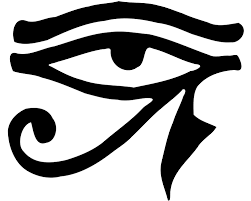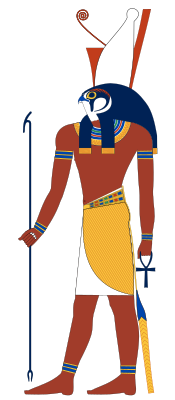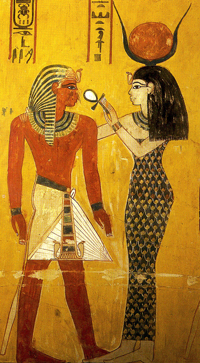
The word Kemetic or Kemet is one that anyone that spends a length of time within the Vampire Community will come across. What does it mean though? Well in the land of Ancient Egypt , the Egyptians themselves did not use the term Egypt Black Land ", in reference to the fertile banks and fields surrounding the Nile (black from the soil). In contrast, "deshret" is the term for the "Red Land Egypt , we refer to the country by the name its own people called it (Egypt
The land of Kemet
Aset Ka was not the only Kemetic Netjer/Netjert (or God/Goddess) that has a place in vampiric history however. There were many that have held a place in our history either as the source of symbols we currently use, customs we take on as our own, or as one of the many Netjer/Netjert that we feel personally drawn to. Below I will list a few of them, though the list is by no means limited to solely those listed.
Atum Ra/Re - Often referred to as the creator of all, this is the Sun God as known in either it's second (Atum) or third (Ra/Re) phase of eclipse (much as the Scarab Khepri was a representation of the dark new moon). In one of his many forms, Ra has the head of a falcon and the sun-disk of Wadjet (one of the patron goddesses of lower Kemet, also called the green one) resting on his head.


Hathor - Often regarded as the wife of Thoth, in later references she has been also depicted as the wife of Ra-Horakhty (Ra/Horus) or in earlier references as the mother of Horus. She was the Nejert that represented the personification of feminine love, joy, music, dance, foriegn lands, and motherhood. She was believed to be the one that welcomed all into this life and the next by helping mothers through childbirth and by greeting the dead when they pass into the afterlife. She is also often depicted in animal form as a cow goddess and has had, since the days of ancient Kemet, a cult following that uses this cow as one of it's many symbols of worship. As is often the case with pantheons throughout history, there are sometimes similarities that overlap. Hathor is one of the female deities that is also associated with the greek goddess Aphrodite.


There is a story about Hathor that has particular interest to someone bearing an eye on vampiric history. Kemet had once been seperated into Upper Kemet and
It is said that Ra (represented by the pharaoh of Upper Kemet) no longer had the respect of his people (those of

Thinking that he was pouring out blood for her in reward for her service, she drank it with frenzied delight, so much of it that she became drunk and fell into a slumber. After waking from this slumber, she had once more returned to her normal, gentle, loving, joyful self as his beautiful Hathor.










No comments:
Post a Comment